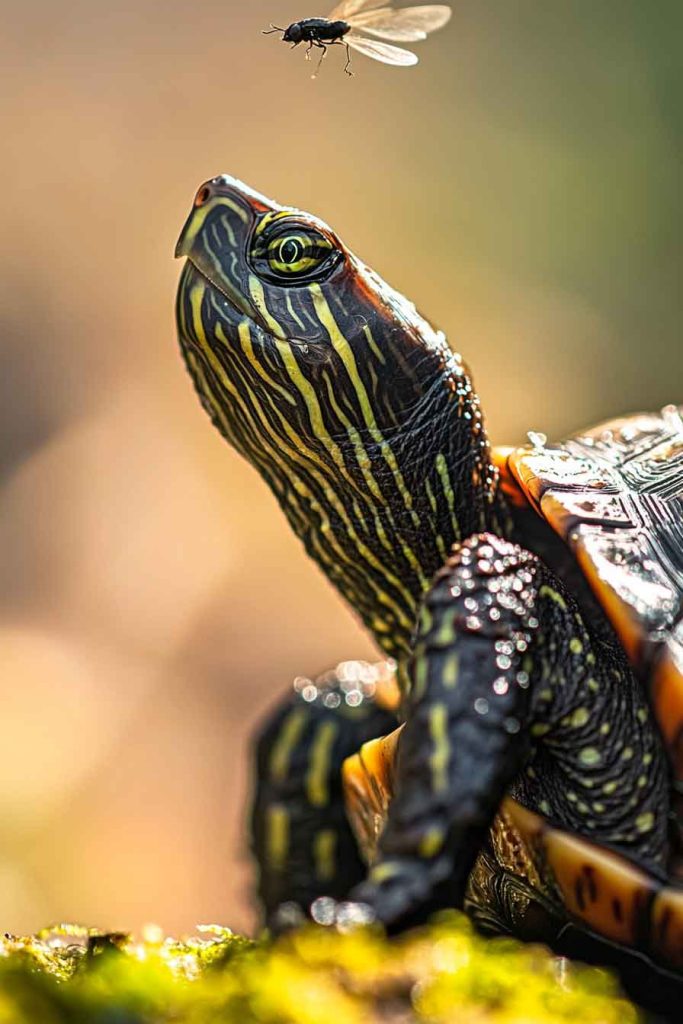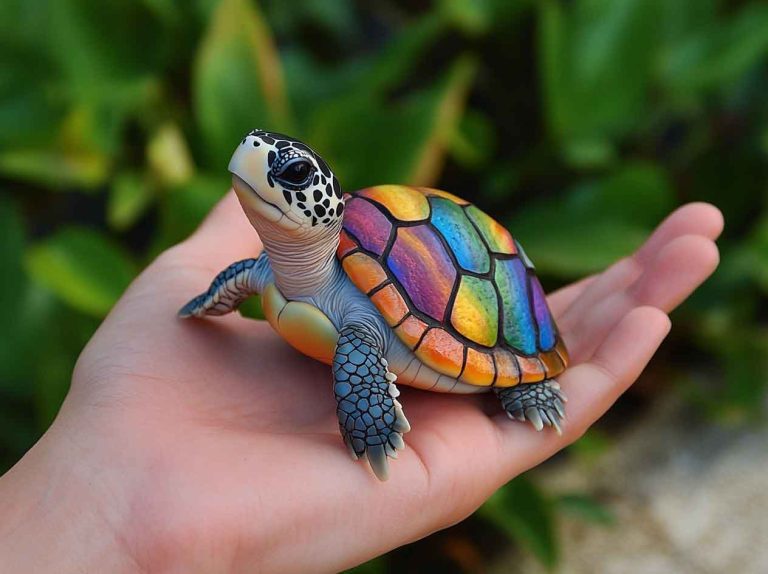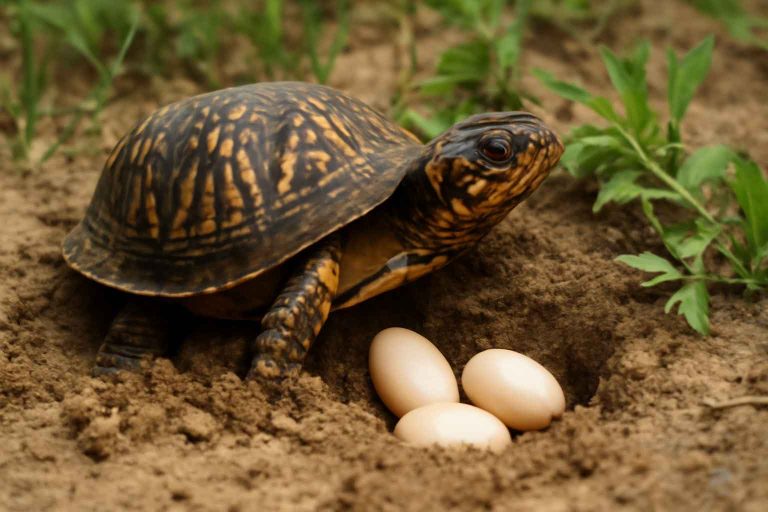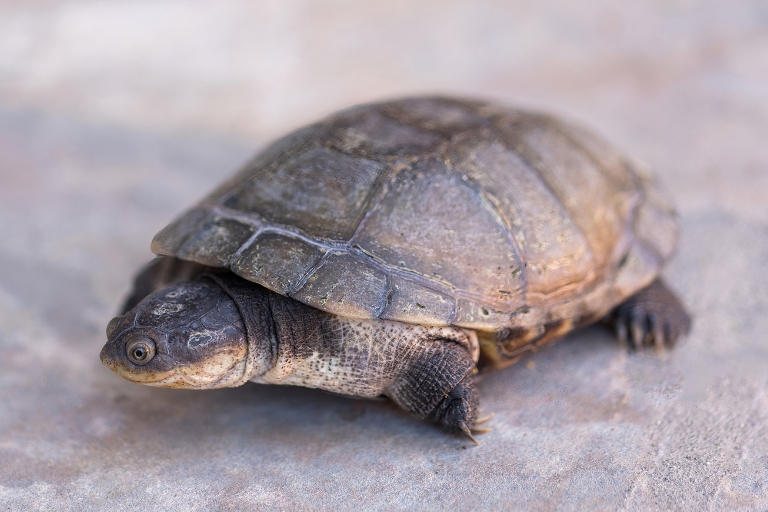Chinese Box Turtle Care Guide for Beginners: Housing, Food, and Maintenance
Have you ever seen a Chinese box turtle? These beautiful turtles have yellow edges on their shells. They also go by other names like Yellow Margined box turtles and Golden-headed box turtles. I find them to be one of the most amazing turtle species you can keep as a pet. But here’s the thing –…
Have you ever seen a Chinese box turtle? These beautiful turtles have yellow edges on their shells. They also go by other names like Yellow Margined box turtles and Golden-headed box turtles. I find them to be one of the most amazing turtle species you can keep as a pet.
But here’s the thing – these turtles are rare and special. They cost a lot of money to buy. So if you’re going to spend that much, you need to know how to take care of them the right way. I don’t want you to waste your money or make your turtle unhappy.
Is it hard to care for Chinese box turtles? Not at all! You just need to learn the right steps. In this guide, I’ll show you everything you need to know. Let’s get started!
Basic Info About Chinese Box Turtle
Before I teach you how to care for these turtles, let me share some basic facts with you:
Scientific Name: Cuora flavomarginata
Common Names: Snake-eating turtle, Yellow Margined box turtle, Golden-headed box turtle
Adult Size: Shell size of 5 to 12 inches long
Maximum Size: A full grown Chinese box turtle can reach 12 inches long
Lifespan: Around 25 to 40 years (that’s a long time!)
Diet: Earthworms, snails, slugs, frozen pinkies, mealworms, and more
Where They Come From: Native to southern China and Taiwan
Behavior: Very active and hungry (voracious)
Eggs per Clutch: One to three eggs
Legal Status in USA: Domestically bred box turtles are legal to keep; wild-caught ones are not
Conservation Status: Endangered (we need to protect them)

Are Chinese Box Turtles Easy to Take Care Of?
Let me be honest with you. Chinese box turtles are not too hard to care for. But they do need the right conditions to stay healthy and happy.
Think of it this way – if you give your turtle the wrong home, bad food, or poor temperature, it will get sick. But if you follow my guide, your turtle will thrive for many years. I promise it’s not as scary as it sounds!
The key is learning what they need. Once you know that, caring for them becomes easy and fun.
How to Take Care of a Chinese Box Turtle
Now I’m going to teach you the most important parts of Chinese box turtle care. Pay close attention to each section!
1. Set Up the Right Enclosure
The size of your turtle’s home matters a lot. Here’s what I recommend:
For Baby and Young Turtles: Start with a 20-gallon aquarium. This gives them enough space when they’re small.
For Adult Turtles: You need at least a 40-gallon aquarium. Bigger is even better!
Why does size matter? Your turtle needs room to move around and exercise. A cramped space will make your turtle stressed and unhappy. I’ve seen turtles in small tanks try to walk through the glass walls over and over. This is a sign they need more space.
A larger enclosure also helps with air flow. Good air circulation keeps your turtle healthy and prevents bad smells.
Pro Tip: Remember that baby turtles grow fast. Don’t be surprised if you need to upgrade the tank in a year or two.
2. Keep the Temperature Perfect
Temperature is super important for Chinese box turtles. Let me break it down for you:
General Tank Temperature: Keep the overall temperature between 80°F and 85°F (26.6°C to 30°C).
Basking Spot Temperature: This warm area should be between 86°F and 95°F (30°C to 35°C).
For Baby Turtles: Keep the room temperature at 77°F (25°C) during the day.
How do you control temperature? I use heating accessories like:
- Heat lamps
- Heat pipes
- Heat tapes
- Heat cables
But be careful! Always watch these heating tools. I’ve seen turtles get burned when heaters get too hot or are placed too close. Use a thermometer to check the temperature every day.
Important: Your turtle needs a temperature gradient. This means one side should be warm (basking area) and another side should be cooler. This lets your turtle choose where it wants to be.
3. Control the Humidity Levels
Chinese box turtles need moisture in the air. The humidity should be between 60% and 80%. I try to keep it around 70% most of the time.
How do you keep humidity right? Here are my tips:
- Mist the enclosure with water once or twice a day
- Use a humidity gauge to measure levels
- Add a dig box (a container with moist substrate)
- Keep a shallow water dish in the tank
The dig box is great because your turtle can go there when it needs more moisture. I fill mine with damp sphagnum moss or coconut coir. Your turtle will love it!
If the air is too dry, your turtle’s shell can crack. If it’s too wet, your turtle might get respiratory infections. Finding the right balance is key.
4. Provide UVB Lighting
This is something I can’t stress enough – Chinese box turtles NEED UVB light!
Why? UVB light helps turtles make vitamin D3. Without it, they can’t absorb calcium properly. This leads to soft shells and weak bones.
What to Use: Get a 5.0 UVB bulb designed for reptiles. Place it about 10-12 inches above the basking area.
Light Schedule:
- Turn the UVB light ON for 10-12 hours during the day
- Turn it OFF at night
Important Warning: Don’t use red, blue, or black lights at night. Your turtle can see these colors and it will mess up their sleep. Complete darkness at night is best.
Replace your UVB bulb every 6-12 months even if it still looks bright. The UVB rays weaken over time even though the light still works.

5. Choose the Best Substrate
The substrate is what you put on the bottom of the tank. This matters because your turtle walks on it every day.
My Top Choice: Indoor/outdoor carpet or reptile carpet topped with timothy hay. The hay gives your turtle something to dig through and explore. It’s also great for their feet and nails.
Other Good Options:
- Paper towels (easy to clean, cheap)
- Newspaper or newsprint
- Alfalfa pellets
- Butcher paper
- Coconut coir (holds moisture well)
- Cypress mulch
What to Avoid:
- Cedar or pine shavings (toxic to turtles)
- Sand (can cause impaction if eaten)
- Gravel (hard to clean, uncomfortable)
I clean the substrate regularly. Spot clean daily and do a full change every 2-4 weeks. A clean environment prevents infections and parasites.
6. Feed a Balanced Diet
Chinese box turtles are omnivores, but they lean more toward eating meat. Let me share my feeding formula with you:
The Perfect Diet:
- 50% animal protein
- 40% vegetables and leafy greens
- 10% fruits
Animal Protein Sources:
- Earthworms (my turtle’s favorite!)
- Slugs
- Snails
- Crickets
- Roaches
- Mealworms
- Waxworms (as treats)
- Frozen pinkies (baby mice – occasionally)
- High-quality turtle pellets
Vegetables and Greens:
- Collard greens
- Dandelion greens
- Mustard greens
- Turnip greens
- Squash
- Carrots
- Bell peppers
Fruits (Limited):
- Berries
- Melon
- Mango
- Banana
- Papaya
Foods to Avoid:
- Too much kale (causes urinary problems)
- Too much spinach (blocks calcium absorption)
- Too much broccoli (causes gas and digestive issues)
- Cat or dog food (too much protein, causes kidney damage)
- Processed human food
Feeding Schedule:
- Baby and young turtles: Feed every day
- Adult turtles: Feed every other day
Supplements:
I add calcium powder to my turtle’s food 2-3 times per week. This keeps the shell strong. Once a week, I also add a reptile multivitamin.
How Much to Feed: Give your turtle as much as it can eat in 15-20 minutes. Remove uneaten food to keep the tank clean.
7. Create a Proper Water Area
Chinese box turtles need both land and water. I set up my tank with 50% land and 50% water.
Water Depth: The water should be shallow – about 2-4 inches deep. Your turtle should be able to stand on the bottom with its head above water.
Water Quality: Change the water every 2-3 days. Use a water filter if possible. Dirty water causes shell rot and infections.
Water Temperature: Keep the water between 75°F and 80°F (24°C to 27°C).
What Turtles Do in Water:
- Drink
- Soak
- Poop (this is why you need to change water often!)
- Cool down when they’re too hot
Some people use a separate soaking tub. I prefer having water in the main tank so my turtle can access it anytime.
8. Add Decorations and Hiding Spots
Your turtle needs places to hide and explore. This makes them feel safe and reduces stress.
What I Include:
- Cork bark hideouts
- Live or fake plants
- Rocks (make sure they’re stable and won’t fall)
- Logs
- Caves
Make sure decorations don’t have sharp edges. I also secure everything so it won’t tip over and hurt my turtle.

Setting Up the Perfect Enclosure – Step by Step
Let me walk you through setting up a complete Chinese box turtle habitat:
Step 1: Choose a 40-gallon or larger tank (for adults)
Step 2: Add substrate (2-3 inches of cypress mulch or coconut coir)
Step 3: Create a land area and a water area
Step 4: Place a hide on the land side
Step 5: Add a shallow water dish or pool
Step 6: Install UVB lighting over the basking area
Step 7: Add a heat lamp over the basking spot
Step 8: Place thermometers on both the warm and cool sides
Step 9: Add a humidity gauge
Step 10: Decorate with plants, rocks, and logs
Step 11: Let everything run for 24 hours before adding your turtle
Step 12: Check all temperatures and humidity levels
Now your turtle has a perfect home!
Health Issues to Watch For
Even with great care, turtles can get sick. Here are warning signs I watch for:
Shell Problems:
- Soft spots on the shell (calcium deficiency)
- White patches (shell rot)
- Cracks or damage
Respiratory Issues:
- Wheezing or clicking sounds
- Mucus around nose or mouth
- Gaping mouth
- Lethargy
Eye Problems:
- Swollen or puffy eyes
- Closed eyes
- Discharge
Eating Problems:
- Refusing food for more than a week
- Weight loss
Behavior Changes:
- Not moving much
- Staying in water all the time
- Not basking
If you see any of these signs, take your turtle to a reptile veterinarian right away. Don’t wait and hope it gets better on its own.
Can You Keep Chinese Box Turtles as Pets?
Yes! Chinese box turtles make wonderful pets if you’re willing to put in the effort. They’re not as big as tortoises, so they don’t need huge outdoor spaces.
But remember – they live 25-40 years. That’s a long commitment! Make sure you’re ready for that before you buy one.
I love watching my turtle explore its tank. They have curious personalities and recognize their owners. Some even come to the glass when they see you!
How Much Do Chinese Box Turtles Cost?
Let me be real with you – these turtles are expensive. Here’s what you should expect to pay:
The Turtle Itself: $200 to $800+ (depending on age and breeder)
Initial Setup Costs:
- Tank: $100-$300
- UVB light and fixture: $50-$100
- Heat lamp and bulb: $30-$50
- Substrate: $20-$40
- Decorations: $50-$100
- Thermometers and humidity gauge: $20-$30
Monthly Costs:
- Food: $20-$40
- Electricity: $10-$20
- Substrate changes: $10-$20
Yearly Costs:
- Veterinary check-up: $50-$150
- UVB bulb replacement: $25-$50
Total first-year cost can be $800-$1,500 or more. After that, expect to spend $300-$500 per year.
Finding a Healthy Chinese Box Turtle
When you’re ready to buy your turtle, look for these signs of good health:
Good Signs:
- Clear, bright eyes
- Active and alert behavior
- Clean nose and mouth (no mucus)
- Firm, smooth shell
- Good weight (not too thin)
- Swims and walks normally
Bad Signs:
- Swollen or closed eyes
- Lethargic or unresponsive
- Shell rot or soft spots
- Very thin or very overweight
- Breathing problems
Always buy from reputable breeders, not wild-caught turtles. Wild-caught turtles are often stressed, sick, and illegal in many places.
Common Mistakes to Avoid
I’ve learned from my mistakes, so you don’t have to! Here are common errors new owners make:
Mistake 1: Using a tank that’s too small. Don’t cheap out on tank size!
Mistake 2: No UVB lighting. This is non-negotiable. Your turtle will get sick without it.
Mistake 3: Wrong diet. Don’t just feed your turtle one or two foods. Variety is key.
Mistake 4: Dirty tank. Clean up waste daily and change water regularly.
Mistake 5: Wrong temperature. Always use thermometers to verify temperatures.
Mistake 6: Handling too much. Turtles get stressed with excessive handling. Let them be!
Mistake 7: No hiding spots. Turtles need privacy and security.
Mistake 8: Skipping vet visits. Find a reptile vet before you need one.
Frequently Asked Questions
Let me answer some common questions I get:
Q: Can Chinese box turtles live with other turtles?
A: It depends. Some turtles get along, others fight. I recommend keeping them separate unless you have a very large space and monitor them closely.
Q: Do they hibernate?
A: In the wild, yes. In captivity, I don’t recommend it for beginners. Keep temperatures stable year-round.
Q: Can I let my turtle roam the house?
A: Not unsupervised. They can get lost, injured, or eat something dangerous. Short, supervised floor time is okay.
Q: How often should I handle my turtle?
A: Limit handling to a few times per week. When you do handle them, wash your hands before and after.
Q: Can they eat cat or dog food?
A: No! These foods have too much protein and wrong nutrients. Stick to proper turtle diet.
Q: Do they bite?
A: They can bite if scared or mistake your finger for food. Their bite isn’t usually serious, but be gentle when handling.
Q: How do I know if my turtle is male or female?
A: Males usually have longer tails and a concave plastron (bottom shell). Females have shorter tails and flat plastrons. It’s hard to tell when they’re young.
Q: Can they live outside?
A: Only if you live in a warm climate similar to their natural habitat. Most people should keep them indoors.
My Personal Tips for Success
After years of keeping Chinese box turtles, here’s what I’ve learned:
Tip 1: Keep a care journal. Write down feeding times, temperatures, and any health issues. This helps you spot patterns.
Tip 2: Take photos of your turtle regularly. This helps you monitor growth and shell health.
Tip 3: Build a relationship with a reptile vet before emergencies happen.
Tip 4: Join online turtle communities. You can learn so much from experienced keepers!
Tip 5: Be patient. Some turtles take weeks or months to settle in and feel comfortable.
Tip 6: Prepare for travel. Find someone who can turtle-sit when you’re away.
Tip 7: Quarantine new turtles. If you add a second turtle, keep them separate for 30-60 days first.
Tip 8: Enjoy the journey! Watching your turtle grow and thrive is incredibly rewarding.
Conclusion
Taking care of Chinese box turtles isn’t as hard as it seems. Yes, they need the right setup, proper temperature, good humidity, UVB lighting, and a balanced diet. But once you have everything in place, daily care is pretty simple.
I love my Chinese box turtle. It brings me joy every single day. If you follow the advice in this guide, your turtle will live a long, healthy, happy life.
Remember – these turtles can live 25-40 years. That means your turtle could be with you for decades! It’s a big responsibility but also an amazing privilege.
Are you ready to give a Chinese box turtle the perfect home? I hope this guide helps you feel confident and prepared. Your turtle is lucky to have an owner who cares enough to learn how to do things right.
Good luck with your turtle keeping adventure! If you take good care of your Chinese box turtle, you’ll have a wonderful companion for many years to come.







